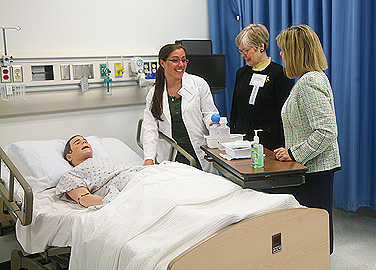News
Nursing celebrates new home in Wende

Heather Martin (left), a senior nursing student, demonstrates Homer, one of the School of Nursing’s talking patient mannequins, to Dean Jean Brown (center) and alumna Connie Vari, COO of Kaleida Health. Photo: CHUCK TOY
-
 Print
Print -
 Comments
Comments
-
“The vision of our School of Nursing is to be among the top 25 nursing schools in the country, recognized for our commitment to leadership and quality.”
The School of Nursing welcomed guests to its new home during a grand opening reception on Tuesday that included tours of its new clinical facilities in Wende Hall on the South Campus.
The school has fully occupied Wende and is holding classes there this semester. It spent more than 30 years occupying the upper floors of Kimball Tower, also on the South Campus.
The $7.1 million renovation of historic Wende—constructed in 1885 and expanded in 1955—has transformed it into a user-friendly, energy-efficient and dynamic setting for 21st-century nursing education. The facility includes state-of-the-art classrooms, instructional laboratories and research space, along with new elevator, air conditioning and heating systems. The teaching spaces in the building include a center for nursing research, three specialized laboratories, faculty offices, and student and employee lounges.
During the grand opening ceremony, UB administrators renewed commitments to provide the most up-to-date and comprehensive education for nursing students as nurses take on more responsibilities in the ever-changing health care industry.
“With the well-documented shortage of nurses, education preparation becomes even more important to the health and well-being of our community,” said David L. Dunn, vice president for health sciences. “And the newly renovated Wende Hall is critical in our plans for educating nurses.”
On hand for the grand opening were nursing school alumni, students, faculty and staff, as well as members of the health care community. Guests toured Wende’s state-of-the-art simulation labs—equipped with talking “patient” mannequins—and examination rooms that now are central in the school’s revised curriculum.
“The vision of our School of Nursing is to be among the top 25 nursing schools in the country, recognized for our commitment to leadership and quality,” said Dean Jean Brown. “Our mission is to produce outstanding clinicians and researchers who meet the needs of our society. We seek a highly collaborative faculty with seamlessly integrated clinical and research practices.
“The role of nurses has continued to expand with time,” she added. “Today, nurses provide primary patient care, initiate treatment and make independent decisions about prevention and rehabilitation.”
The nursing school’s move to the renovated Wende Hall represents another milestone in the UB 2020 plan to improve university facilities and enhance living and learning spaces on UB’s three campuses, said Provost Satish K. Tripathi.
“As part of UB 2020’s master physical plan ‘Building UB,’ we are developing new learning spaces and facilities such as what we now have in Wende Hall. We know that these state-of-the art physical improvements will make UB competitive with the very best universities in the nation,” he said.
The nursing school’s move to Wende also is consistent with the UB 2020 plan to locate all five of UB’s health sciences schools on one campus. Renovations are now under way to remake nearby Acheson Hall into the new home for the School of Pharmacy and Pharmaceutical Sciences, which currently is located on the North Campus.
The new facilities at Wende include more than 4,000 square feet for the Center for Nursing Research to support the school’s emphasis on research as an essential tool for educating nurses to meet the needs of patients. An operating suite for the school’s anesthesia program will advance UB’s nursing education into the 21st century and prepare nurses to be key members of integrated health care teams in a variety of health settings.
Brown noted that the expanding role of nurses—along with the well-documented nationwide nursing shortage—means nursing schools face a serious challenge to train qualified nurses. The high morbidity rates that have been linked to nursing shortages mean nothing less than saving lives is at stake, she said.
To keep up with these demands, the school has initiated numerous program innovations, including an accelerated bachelor of science program—a resource-efficient, second-degree program that produces new graduates in 12 months. The school also offers two programs leading to a bachelor's degree in nursing and seven master's programs, including five nurse practitioner programs, a clinical nurse specialist program and a nurse anesthesia program. All master's programs are being converted to the clinical-focused doctor of nursing practice degree program, expected to be offered in fall 2010; the school currently offers the research-focused doctor of philosophy degree program.
The school’s innovative Dedicated Education Units, or DEUs, is a new curriculum in which hospital administrators, nurse-clinicians and UB faculty combine their experience to give students a relevant and interdisciplinary clinical experience. This approach also emphasizes patient simulation, a concept the school’s new labs are well equipped to handle. This approach includes the use of talking patient mannequins (nicknamed Samson and Homer) to give students a realistic view of what they can expect in clinical settings.
In addition, nursing faculty members have formed research/scholarly teams to encourage and support collaboration. The new offices in Wende have been designed to help faculty organize around this cooperative approach.

Reader Comments